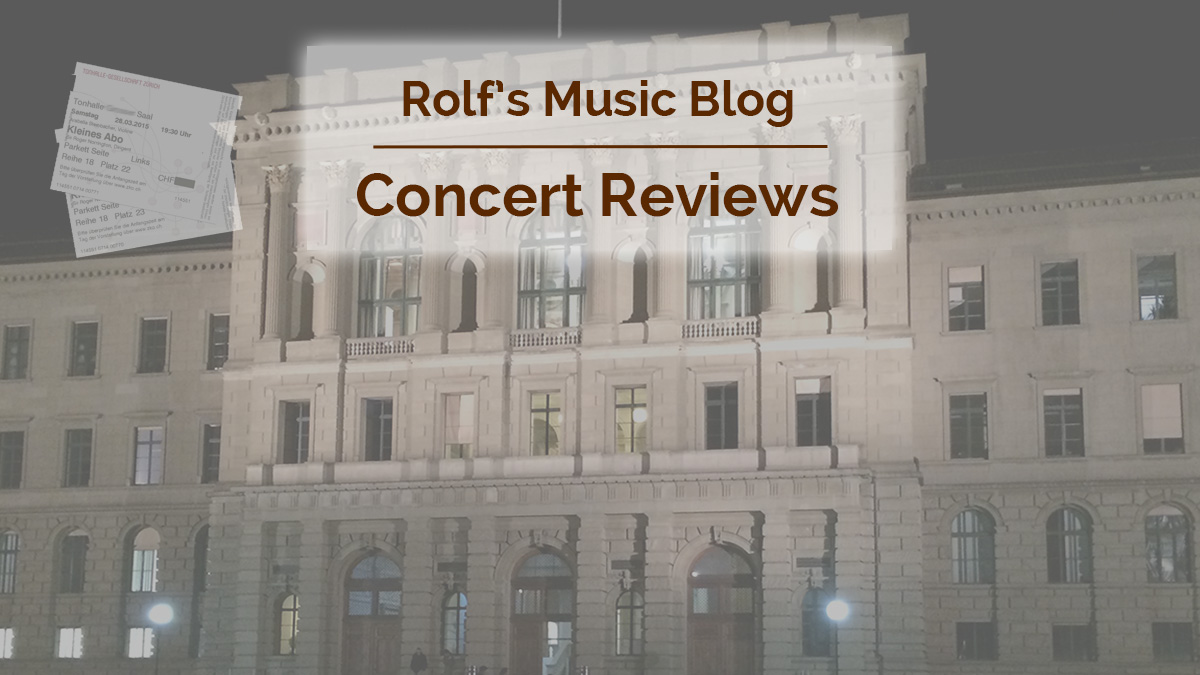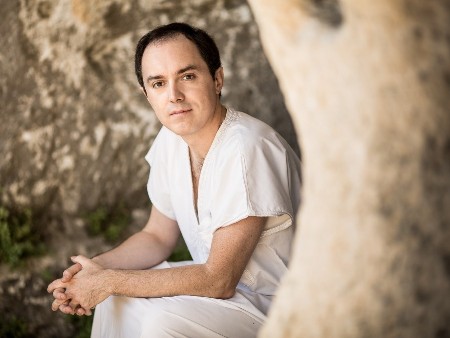Piano Recital: Alessandro Marangoni
Castelnuovo-Tedesco
Semper-Aula, ETH Zurich, 2016-03-22

2016-03-26 — Original posting
2016-10-09 — Brushed up for better readability
Table of Contents
The Artist: Alessandro Marangoni
Alessandro Marangoni was born 1979 in Mortara / Lombardia. He did his piano studies with Marco Vincenzi and Maria Tipo at the music school in Fiesole. He also studied and graduated in philosophy at the Università di Pavia. Marangoni is now pursuing an international career as recording and concert pianist, both as soloist and as chamber musician (see his Wikipedia entry for additional information). He is also teaching master classes in Europe and in South America. For this Easter Concert in the Semper-Aula at the ETH in Zurich, Alessandro Marangoni brought along a team of three people, to deal with the visual aspects of the recital, see below.
The Composer: Mario Castelnuovo-Tedesco
The name Mario Castelnuovo-Tedesco (1895 – 1968) may be just vaguely familiar to music lovers outside Italy. Very few will be able to name one of his compositions. Yet, judging from the size of his compositorial output, he is anything but negligible among the Italian composers of the 20th century. He is one of the most important authors of music for the guitar in recent times, also outside of Italy. When Fascism became too oppressive prior to the start of the Second World War, Castelnuovo-Tedesco emigrated to the United States. He moved to California and turned towards composing film music: he was provided music for about 200 Hollywood movies. Besides that, he also composed operas, concertos for famous artists, plus additional instrumental and vocal music.
The Work: Evangélion
Mario Castelnuovo-Tedesco also created a small number of compositions for piano. The last one of these, written in 1949, is “Evangélion” (The Story of Jesus), op.141 — the composition that Alessandro Marangoni selected for his recital. Even just within Castelnuovo-Tedesco’s oeuvre, “Evangélion” is a little known “niche product”. Consequently, the number of listeners in this concert was very small, filling only about 1/3 of the already small venue (the Semper-Aula holds only 100 seats). Some may have felt that this is music for children and therefore not worth a visit. Indeed, the full title of the composition is “Evangélion. La storia di Gesù, narrata ai fanciulli in 28 piccoli pezzi per Piano” (The story of Jesus, narrated for children, in 28 short pieces for piano), but that doesn’t say much about the experience in that recital.
The Structure
The 28 pieces in “Evangélion” are arranged in four groups of around 7 pieces each (only the English titles are given here), covering the life of Jesus as described in the bible, from the annunciation up to the resurrection:
- The Infancy
- The Annunciation
- The Nativity
- The Three Kings
- The Massacre of the Innocents
- The Flight to Egypt
- Child Jesus and the Doctors
- The Life
- The Baptism on the Jordan
- The Dance of Salome
- By the Sea of Galilee
- Jesus Walking on the Waves
- The Woman of Samaria
- The Resurrection of Lazarus
- Mary Magdalene
- Jesus and the Money Changers
- The Words
- The Sermon on the Mount
- Pater Noster (Our Father who art in Heaven)
- Sinite parvulos venire ad me (Jesus and the Little Children)
- Invective (Woe unto you, Scribes and Pharisees, Hypocrites)
- The Wise Virgins and the Foolish Virgins
- The Lost Sheep
- The Return of the Prodigal Son
- The Passion
- Hosanna (The Entrance into Jerusalem)
- The Last Supper
- Gethsemane (The Prayer in the Garden)
- Crucifige! (Before Pontius Pilate)
- Golgotha (On the Way to the Calvary)
- The Last Words
- The Resurrection
A Look at the Music
The 28 character pieces are between 1 and 4 minutes in duration each. Castelnuovo-Tedesco draws from a wide range of styles / characters / textures: some pieces (especially in the first parts) are relatively simple, descriptive (but not strikingly concrete, or too trivial); some use canon-like polyphony, some are homophonic (melody line plus accompaniment), yet others are more rhythmic, if not percussive.
In my perception, the music is not so much melodic, rather based on motifs or short melody fragments. Rarely, these fragments form a longer melody that one might remember. Even if they do so, Castelnuovo-Tedesco does not treat them as “themes” (recurring melodies), but (even within such short pieces) he keeps adding new ideas / motifs. Consequently, the pieces are typically devoid of a recognizable structure. It’s the pieces which form the overall structure of the composition, forming build-ups, starting with simple, serene movements, progressing into a dramatic climax within a group, such as No.4 (“The Massacre of the Innocents”), No.18 (“Invective”), and of course the pieces relating to the crucification in part IV.
Some pieces are almost ethereal, serene, and also technically simple, while others are full of life and action, and technically much more demanding. It’s difficult to locate the style of this music: there were pieces that reminded me of piano music by Pyotr Ilyich Tchaikovsky (1840 – 1893), others harmonically seemed to allude to music by Nikolai Medtner (1880 – 1951) or Sergei Rachmaninoff (1873 – 1943). In essence, Castelnuovo-Tedesco was writing in his own, personal style that can vaguely be described as late romantic. In all this, one should keep in mind that “Evangélion” was composed for children.
The Recital
Alessandro Marangoni’s playing clearly reflected his thorough work, his experience with this composition. His interpretation was rich in dynamic gradations, from subtle and gentle up to (rarely) dramatic outbreaks, unpretentious and serving the music he was playing. He was not trying to expose virtuosity — in line with his modest demeanor.
However, the evening wasn’t just about the “naked” music, but rather a Gesamtkunstwerk (or key parts thereof) in which the pianist played an essential role. Primarily, this composition is associated with underlying text, a narrative based on the New Testament in the bible. Alessandro Marangoni has expanded and enriched this by adding a visual component: along with the music and the recitation of the text, images were projected onto a tulle screen behind the concert grand, from the far end, towards the audience, through the screen, upwards onto the ceiling. The auditory remained mostly dark, except that on the stage behind the piano, the side walls and the ceiling received color lighting: blue — green — green — red, marking the four groups of episodes / character pieces.

The Gesamtkunstwerk
Marangoni has performed this Gesamtkunstwerk successfully and repeatedly in Italy, with an actress reciting the text in a very clear and understandable language. Even most non-Italians should understand the content, provided they have a vague idea about the contents of the bible.
Sadly, in Zurich, the text component was missing. On the other hand, this not only kept the duration of the concert in limits, but it primarily allowed the audience to focus on the music and the pictures. The latter were at least as important as the music, often even spectacular. Alessandro Marangoni drew from a vast collection of image material: photos, paintings, mosaics, frescoes, painted glass, even the Turin grave cloth.
In terms of subjects / topics or actual content, the images covered nature, sunrise & sunset, pictures from antiquity up to the famous Dutch painters, Leonardo da Vinci’s “Last Supper”, Italian altar paintings, art from expressionism to Marc Chagall, up to surrealism, from the highest of arts to cheap Holy paintings.
The images changed every couple of seconds, and all images were moving, i.e., it wasn’t simple slides, but a video projection of excerpts from an image / picture, whereby the section shown was slowly moving over the image. The image fragments ranged from nearly total images down to smallest fragments, e.g., blood droplets on Jesus Christ’s head / skin, or a detail from Hieronymus Bosch’s “Garden of Earthly Delights”.
Dramatization
Dramatization was achieved by showing grotesque-naturalist heads, faces, hands, etc. from Dutch paintings, contrasting to idealized or simplified paintings / drawings of Christ’s face. Overall, a fascinating, ever-changing roundelay of well-selected and assorted images. In addition, during the production of the video, sections of some images must have been projected onto a subtly moving / oscillating or uneven surface, which made them appear mysteriously alive (in one case, also a moiré-effect helped creating that impression). Some images may have been naïve, even trivial — but as a part of this rich sequence / “movie”, they fitted into the context, helped creating the atmosphere. They contributed to the overall impression just as much as the most artful paintings of Dutch or antique artists.
Note: my description of the pictures shown is fragmentary. I’m quoting from memory what I captured in this one performance, and I’m not an expert in history of arts.
Conclusion / Encore
Too bad that the text was missing (also the original text in Italian would have served its purpose here). But even just the combination of visuals and music resulted in an interesting, multi-faceted, dramatic and rich sequence of impressions. Despite the short breaks between the pieces, the audience experienced an impressive build-up and intensification in the course of the evening.
It was definitely worth the experience overall. I doubt that the music of these 28 pieces alone would form a viable basis for a concert evening, even if they are presented as masterfully, aptly and perceptively as in Alessandro Marangoni’s recital. But with this combination of visual and auditory art, the pianist and his lighting / projection crew (Stefano Sgarella, direction; Carlo Caiaffa, light; Veronica Gariboldi, images) allowed for an enriching concert experience. It was a pity that there weren’t more people enjoying this. Thanks to the darkness in the room, the large number of empty seats had little effect on the individual experience.
As an encore, Alessandro Marangoni played the Nocturne in C♯ minor, op.posth., by Frédéric Chopin (1810 – 1849): music that is entirely different in character — but a very atmospheric and fitting closure of the evening!
Addendum 1
Alessandro Marangoni’s interpretation of “Evangélion” is available on CD (I have not listened to that CD myself, except through Spotify):

Castelnuovo-Tedesco: Evangélion (The Story of Jesus)
Alessandro Marangoni
Naxos 8.573316 (CD, stereo); ℗ / © 2014


Addendum 2
For the same concert, I have also written a (shorter) review in German for Bachtrack.com. This posting is not a translation of that German review, the rights of which remain with Bachtrack. I create the German review using a subset of the notes taken during this concert. I wanted to enable my non-German speaking readers to read about my concert experience as well. Therefore, I have taken my original notes as a loose basis for this separate posting. I’m including additional material that is not present in the Bachtrack review.



